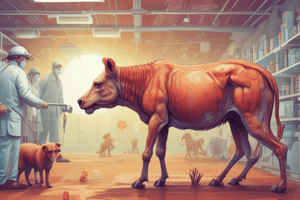Podcast
Questions and Answers
Which of the following pathogens is transmitted through fomite transmission?
Which of the following pathogens is transmitted through fomite transmission?
- Rabies
- Bordetella bronchiseptica
- Canine parvovirus (correct)
- Leptospira interrogans
Which zoonotic infection is primarily spread through vector-borne transmission?
Which zoonotic infection is primarily spread through vector-borne transmission?
- Salmonella
- Bartonella (correct)
- Parvovirus
- Leptospira
Which route of pathogen spread is most associated with direct contact with affected tissues or fluids?
Which route of pathogen spread is most associated with direct contact with affected tissues or fluids?
- Fomite transmission
- Direct contact (correct)
- Aerosol
- Oral transmission
Which of the following is NOT a concern for infection control in a small animal hospital?
Which of the following is NOT a concern for infection control in a small animal hospital?
Which pathogen is primarily linked to aerosol transmission?
Which pathogen is primarily linked to aerosol transmission?
What characterizes pathogen spread via oral transmission?
What characterizes pathogen spread via oral transmission?
Which pathogen is associated with fecal-oral transmission?
Which pathogen is associated with fecal-oral transmission?
Which of the following statements about zoonotic infections is accurate?
Which of the following statements about zoonotic infections is accurate?
Which of the following best describes biosecurity in veterinary practices?
Which of the following best describes biosecurity in veterinary practices?
What is the primary focus of biosafety within a veterinary context?
What is the primary focus of biosafety within a veterinary context?
Which of the following represents a breach of infection control prevention and biosecurity (ICPB)?
Which of the following represents a breach of infection control prevention and biosecurity (ICPB)?
Which term describes an infectious disease that can be transmitted between humans and animals?
Which term describes an infectious disease that can be transmitted between humans and animals?
What are the potential impacts of breaches in infection control, prevention, and biosecurity?
What are the potential impacts of breaches in infection control, prevention, and biosecurity?
What roles may veterinarians play during a pandemic?
What roles may veterinarians play during a pandemic?
In the context of infection transmission routes, which of the following is NOT one of the five main routes of pathogen transmission?
In the context of infection transmission routes, which of the following is NOT one of the five main routes of pathogen transmission?
Which of the following elements is critical in establishing effective biosecurity protocols in veterinary practices?
Which of the following elements is critical in establishing effective biosecurity protocols in veterinary practices?
What should a patient experiencing acute respiratory symptoms not be allowed to do?
What should a patient experiencing acute respiratory symptoms not be allowed to do?
Which of the following chronic infections is particularly concerning before admitting a patient?
Which of the following chronic infections is particularly concerning before admitting a patient?
What is the primary reason for gathering the veterinary patient's vaccination history prior to admission?
What is the primary reason for gathering the veterinary patient's vaccination history prior to admission?
Which question is NOT relevant to ask regarding a pet's recent history?
Which question is NOT relevant to ask regarding a pet's recent history?
What cleaning method involves the use of warm water and detergent?
What cleaning method involves the use of warm water and detergent?
What is the consequence of not adhering to designated contact time for disinfectants?
What is the consequence of not adhering to designated contact time for disinfectants?
What is a common misconception about disinfectant usage?
What is a common misconception about disinfectant usage?
Which of the following is a step NOT included in the general cleaning and disinfection plan?
Which of the following is a step NOT included in the general cleaning and disinfection plan?
What is the primary role of the Infection Control Practitioner (ICP)?
What is the primary role of the Infection Control Practitioner (ICP)?
Which of the following is an example of an engineering control in infection prevention?
Which of the following is an example of an engineering control in infection prevention?
Which practice is essential for managing the risk of pathogen spread in veterinary settings?
Which practice is essential for managing the risk of pathogen spread in veterinary settings?
What is a recommended method for proper hand hygiene?
What is a recommended method for proper hand hygiene?
What should be done to minimize the risk of staff entering infectious areas?
What should be done to minimize the risk of staff entering infectious areas?
What is the purpose of developing standard operating procedures (SOPs) related to infection control?
What is the purpose of developing standard operating procedures (SOPs) related to infection control?
What is the function of negative pressure ventilation in isolation areas?
What is the function of negative pressure ventilation in isolation areas?
What is a key preventive measure regarding vaccinations for staff?
What is a key preventive measure regarding vaccinations for staff?
How should vectors like ticks be handled according to infection control measures?
How should vectors like ticks be handled according to infection control measures?
What should be included in client education materials regarding biosecurity?
What should be included in client education materials regarding biosecurity?
What is the correct order for putting on personal protective equipment (PPE) before entering the isolation room?
What is the correct order for putting on personal protective equipment (PPE) before entering the isolation room?
What should be done with used disposable PPE after providing care in an isolation room?
What should be done with used disposable PPE after providing care in an isolation room?
Which of the following items should not be brought into the isolation room?
Which of the following items should not be brought into the isolation room?
What is the best method for cleaning non-disposable PPE after exiting an isolation room?
What is the best method for cleaning non-disposable PPE after exiting an isolation room?
Which characteristics should be applied to the ground material in large dog isolation runs?
Which characteristics should be applied to the ground material in large dog isolation runs?
How should contaminated surfaces be addressed before leaving the isolation room?
How should contaminated surfaces be addressed before leaving the isolation room?
Why is it important to inform clients and staff about zoonotic potential?
Why is it important to inform clients and staff about zoonotic potential?
What should be done after disinfecting hands before leaving the anteroom?
What should be done after disinfecting hands before leaving the anteroom?
Flashcards are hidden until you start studying
Study Notes
Zoonotic Infections
- Rabies, Microsporum canis, Leptospira, Campylobacter, and Bartonella are examples of zoonotic pathogens.
- Veterinarians should be concerned with zoonotic pathogens since they can be transmitted from animals to humans.
Pathogens of Greatest Infection Control Concern
- Adenovirus (canine), Parainfluenza virus (canine), Bordetella bronchiseptica, Parvoviruses (canine, feline), Calicivirus (feline), Respiratory coronavirus (canine), Chlamydophila (feline), Salmonella spp., Distemper virus (canine), Herpesvirus (feline), Influenza viruses (canine, novel), Leptospira interrogans, Microsporum canis, Multidrug-resistant organisms (Acinetobacter spp., Escherichia coli, Enterococcus spp., Staphylococcus spp., Pseudomonas spp.) are all pathogens of concern in a veterinary hospital setting.
- Multidrug-resistant organisms are of particular concern due to the difficulty in treating them.
Transmission Routes of Pathogens
- Direct contact with infected tissues or fluids, bites, or scratches can transmit rabies, Microsporum canis, and Leptospira spp.
- Fomite transmission occurs when an inanimate object, such as a table, kennel, or bowl, becomes contaminated and leads to infection. Canine parvovirus is an example of this transmission route.
- Aerosol transmission happens when small particles or droplet nuclei are inhaled or land on mucous membranes. This route can transmit Bordetella bronchiseptica, canine influenza, and canine distemper virus.
- Oral transmission involves contaminated food or water, licking or chewing on contaminated surfaces, and can transmit feline panleukopenia, Campylobacter, Salmonella, E. coli, and Leptospira.
- Vector-borne transmission occurs when a living organism carries and transmits pathogenic microorganisms to other animals or places. Examples include heartworm disease, Bartonella infection, and Borrellia burgdorferi infection.
Biosecurity and Biosafety
- Biosecurity focuses on stopping the spread of disease from one person, animal, or place to another, primarily within clinical practice.
- Biosafety focuses on stopping the spread of biohazards from a specific location or preventing harm, primarily in laboratory settings.
- Veterinary practice utilizes biosecurity measures to prevent the spread of pathogens by preventing introduction, exposure, transmission, and infection within the hospital population.
- Laboratory settings utilize biosafety methods to prevent the spread of biohazards from the laboratory.
Infection Control, Prevention, and Biosecurity
- Breaches of ICPB can have medical, social, and financial impacts, affecting patients, clients, staff, and the hospital/clinic’s reputation.
- Early identification of infectious cases is crucial in preventing further exposures and ensuring the safety of the practice.
- Telephone triage allows for early recognition and identification of infectious cases, preventing high-risk patients from entering the main hospital areas.
- Key questions during phone triage include travel history, exposure to other animals, vaccination status, and recent illness.
- Prevention includes elimination of potential sources of infection, engineering of the hospital, and administration of control measures.
- Engineering aspects include hand hygiene stations, non-porous work surfaces, and negative pressure ventilation.
- Administrative aspects include training staff and clients, removing vectors, and vaccinating staff.
- Personal protective equipment (PPE) should be chosen and used appropriately based on the risks associated with patient care.
- Infection Control Practitioner (ICP) is responsible for implementing and evaluating the practice’s infection control measures, ensuring staff compliance and training.
Standard Operating Procedures (SOPs)
- Hand hygiene is a crucial aspect of infection control and includes both washing hands with soap and water and using hand sanitizer.
- Phone triage is a vital step in identifying potential infectious cases before they enter the hospital.
- Questions to ask during phone triage include the patient's recent history, signs of illness, and vaccination status.
- Animals exhibiting acute coughing, sneezing, vomiting, diarrhea, fever, or a MDR should be directed to a separate examination area.
- Isolation protocols are crucial for managing infectious cases and preventing further spread of pathogens.
- Entering an isolation room involves wearing appropriate PPE, using disposable items when possible, and adhering to strict disinfection practices.
- Exiting an isolation room also involves specific steps to prevent contamination, including removing PPE carefully and disinfecting any contaminated surfaces.
- Disposing of urine, feces, and other fluids involves using disposable materials whenever possible, cleaning and disinfecting properly, and following CDC guidelines.
- Communication about zoonotic potential is vital, both for clients and staff, to ensure proper precautions and minimize risk.
- Immunocompromised individuals are at higher risk for contracting zoonotic infections and should be advised to exercise caution.
Studying That Suits You
Use AI to generate personalized quizzes and flashcards to suit your learning preferences.





